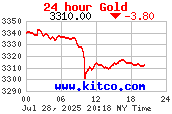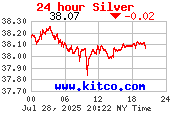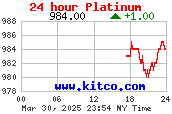金銀鉑價格儘管會變動,但不會像股票一樣變得毫無價值。
黃金:
如計入CPI因素,1980年1月的850美元金價相等於今天2,176美元。
地球上的確定蘊藏量約8萬9,700噸(2007年,USGS),不過有許多礦藏處不易開採,因此可開採蘊藏量只有約4萬1,500噸(2007年,USGS)。
近幾年來,黃金產量大多在2,500噸上下變化,故可採年限只有16.6年。
新開採出來的黃金,加上回收取得的部份,每年大約為4,000噸左右,正好可以應付全球的需求。
黃金的用途:(2007年,WGC)
1. 珠寶飾品:68.4%
2. 工業、牙科用:13.1%
3. 金塊、金幣:12.4%
4. 投資(e.g. ETF):6.1%
黃金的主要需求國前6名:(2007年)
1. 印度:774噸
2. 中國:326噸
3. 美國:278噸
4. 土耳其:249噸
5. 沙烏地阿拉伯:129噸
6. 阿拉伯聯合大公國:107噸
黃金的主要生產國前8名:(2007年)
1. 澳洲:280噸
2. 南非:270噸
3. 中國:250噸
4. 美國:240噸
5. 秘魯:170噸
6. 俄羅斯:160噸
7. 印尼:120噸
8. 加拿大:100噸
黃金的可開採蘊藏量:(2007年,USGS)
1. 南非:6,000噸、14.5%
2. 澳洲:5,000噸、12.0%
3. 秘魯:3,500噸、8.4%
4. 俄羅斯:3,000噸、7.2%
5. 美國:2,700噸、6.5%
6. 印尼:1,800噸、4.3%
7. 加拿大:1,300噸、3.1%
8. 中國:1,200噸、2.9%
9. 其他:17,000噸、41.0%
官方黃金儲備量前10名:(2008年12月)
1. 美國:8,133.5噸
2. 德國:3,412.6噸
3. IMF:3,217.3噸
4. 法國:2,508.8噸
5. 意大利:2,451.8噸
6. 中國:1,054.0噸
7. 瑞士:1,040.1噸
8. 日本:765.2噸
9. 荷蘭:621.4噸
10. ECB:533.6噸
白銀:
在1990年代後半之前,作為感光劑塗在相機底片上的銀化合物類(銀鹽)需求量很大。不過,隨著數碼相機普及,銀在這方面的需求逐漸減少。相機底片以外的需求(牙科、淨水器等殺菌裝置、電線等)反而逐漸增加。
在「廢金屬回收」中所回收的銀,主要來自於用過的相機底片。2006年的廢銀回收量佔了總供給量的21%。
大約75%的銀都是鋅、鉛、銅、金等礦物開採時的副產品,因此這些金屬的需要量也會連帶影響銀的產量。
地球上的確定蘊藏量約56萬9,000噸(2007年,USGS),不過有許多礦藏處不易開採,因此可開採蘊藏量只有約27萬2,000噸(2007年,USGS)。
近幾年來,銀年產量大約2萬噸,故可採年限只有13.6年。
銀的用途:(2006年,GFMS)
1. 珠寶飾品:47%
2. 銀器、珠寶飾品:25%
3. 相機底片:16%
4. 官方發行的錢幣:4%
1. 投資:8%
銀的主要需求國:(2006年,GFMS)
1. 美國:5,778噸、22.1%
2. 日本:4,264噸、16.3%
3. 印度:2,575噸、9.9%
4. 其他:13,525噸、51.7%
銀的主要生產國前8名:(2007年、USGS)
1. 秘魯:3,400噸
2. 墨西哥:3,000噸
3. 中國:2,700噸
4. 澳洲:2,000噸
5. 智利:1,400噸
6. 波蘭:1,300噸
7. 美國:1,220噸
8. 加拿大:1,200噸
銀的可開採蘊藏量:(2007年,USGS)
1. 波蘭:51,000噸、18.8%
2. 墨西哥:37,000噸、13.6%
3. 秘魯:36,000噸、13.2%
4. 澳洲:31,000噸、11.4%
5. 智利:26,000噸、9.6%
6. 美國:25,000噸、9.2%
7. 加拿大:16,000噸、5.9%
8. 其他:50,000噸、18.4%
鉑(白金):
1噸原礦石之中,只能開採出3克左右的白金。鉑有史以來只開採出5,000噸左右,相比黃金的15萬3,000噸,遠為稀少。
鉑廣泛地應用在科學、電腦、醫療、生物等多種領域,其中還包括近年廣受注目的零污染燃料電池,以及抑止汽車排放廢氣的催化劑。
鉑的主要需求國:(2007年,Johnson Matthey)
1. 歐洲:81.7噸、37.4%
2. 中國:39.3噸、18.0%
3. 北美:33.7噸、15.4%
4. 日本:32.5噸、14.9%
5. 其他:31.4噸、14.4%
鉑的主要生產國:(2007年,Johnson Matthey)
1. 南非:156.6噸、76.9%
2. 俄羅斯:28.3噸、13.9%
3. 北美:10.1噸、5.0%
4. 其他:8.7噸、4.3%





5 則留言:
最近本人都查找有關商品投資的資料,金屬,能源和農產品都是十分有趣的工具.
因為知你都對黃金/金幣有興趣,所以請你講解下 Gold Lease Rate, Gold Forward Offer Rate(GOFO), Interbank Offer Rate (IBOR)such as LIBOR, Gold future price的相互影響.
長話短說:
包括石油、黃金、農產品等商品的價格是被「操縱」的!
從供應及需求面分析,散戶們難以預測它們中長期的價格走勢!
從各種技術分析指標,散戶們亦極難以預測它們中短期的價格走勢!
由於它們的價格是被「操縱」的!惟有運用利益分析法才有效用!
So complicated...
Just reponse from the last questions regarding the relationships among gold pricing, gold lease rate and LIBOR
Due to the central banks gold lending activity to gold borrowers (such as gold miners and gold refiners), who can sell the gold to the markets and make USD deposits in banks to earn arbitrage free interest income, if gold lease rate is lower than LIBOR. Hence, I found the following equation for determining the gold forward/future price, which bind the relationship among gold spot price, gold lease rate and LIBOR.
F0 = S0*e^{(r –q)T}
where:
r: continuously compounded risk free annual rate (LIBOR)
q: continuously compounded paid per annum (gold lease rate)
T: time to maturity (years)
S0: current underlying asset price (t=0)
F0:current forward price
^: index factor
Therefore, higher LIBOR and lower gold lease rate make gold forward/future price upswing.
Some explanations of underlying lending activities are like that, for example, if gold lease rate increase substantially and LIBOR remains stable, then gold producers will normally speed up their gold production process and increase the future supply of gold, and makes price downwarding pressure thereotically.
As such, it is normally in contango gold forward/future curve unless gold lease rate is higher than the LIBOR such as in year 1995and year 1999 (Washington Agreement).
Besdies, I also noticed that the gold lease rate is normally maintained at very low level within 0.1%pa to 0.5%pa. Thus, there should be substantial arbitrage activity. Per information, 1,000,000 ounces gold lending with maturity range to 10 years is feasible to transact, although normally maturity is range for few months to half year.
In additions, I agree with you that such pricing model is intrinsic and the spot and forward/future prices are highly influenced by the market spectaculation cashflow and central bank manipulations. Therefore, the pricing is for reference only. However, such selling of gold by borrowers do increase the market pricing efficiency by enabling short positions of gold.
Further eleborate the interrelationship of the driving factors as follows
a) Gold spot price driven
If gold spot price is in increasing trend, borrowers will decrease gold borrowing as selling the borrowed gold into the market at spot price will lock the selling price and profits. The decreasing borrowing will decrease the gold lease rate and it will widen the LIBOR – gold lease rate spread if LIBOR remains stable. It will steepen the gold forward / future price contango curve. The effect is vice versa if gold spot price is in decreasing trend.
b) Gold lease rate driven
If gold lease rate increase and LIBOR remains stable, borrowers (miners and refiners) will speed up gold production processes to reduce interest expenses in gold borrowing, increase gold supply in future, and make decreasing pressure for gold futures / forwards price and flatten the gold forward / future price contango curve.
If gold lease rate increase and LIBOR remains stable, the spread becomes narrow, and decrease the arbitrage activities for selling gold and makes USD deposits. It makes increasing pressure for LIBOR. As LIBOR increase may widening the spread, and steepening the gold forward / future price contango curve (counteract effect – may in minor influence).
c)LIBOR driven
If LIBOR increase with gold lease rate remains stable, the spread becomes widen. It will steepen the gold forward / future price contango curve immediately, and increase the arbitrage activities for selling gold and makes USD deposits (assume the deposits have limited effect on LIBOR), it will increase the gold lease rate later.
發佈留言